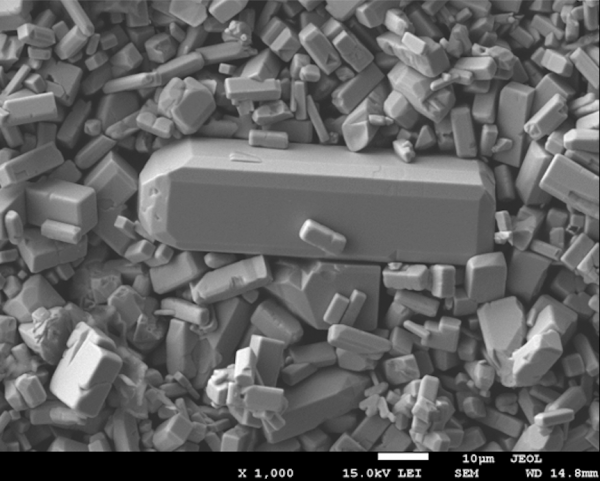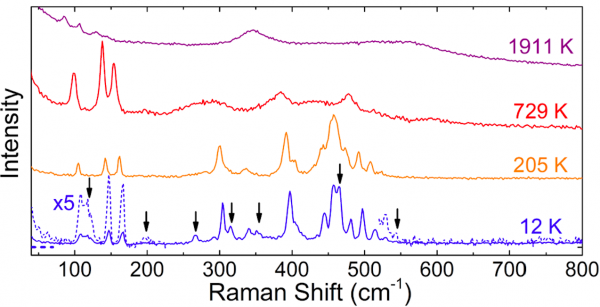First-ever rare earth nickelate single crystals lead to first experimental evidence supporting predicted multiferroicity
by Carey Sargent, EPFL, NCCR MARVEL
The electronic properties of perovskites and other materials with highly correlated electrons are hugely interesting, both to fundamental research being done in condensed-matter physics and chemistry and for their potential use in a wide range of applications.
In particular, rare earth nickelates with the general formula RENiO3, where R is a trivalent rare earth, are good candidates for these applications—and fascinating territory for theoretical study—because of the interdependence of their structural, electronic, and magnetic order parameters. These materials feature, for example, spontaneous metal to insulator transitions at a given temperature that is strongly determined by the radius of the R3+ ion in the specific material.
Investigating the role and interplay of each of these three parameters poses significant challenges for state-of-art theoretical models based on density functional and dynamical mean-field theory methods though. Ideally, theoretical researchers could improve their models by comparing predictions with experimental data. This information is in very limited supply though because of the scarcity of nickelate single crystals suitable for investigation.
Though some band structures have been reported for nickelate thin films, their properties tend to differ from those of bulk samples because of strong dependence on variables such as the film thickness or lattice mismatch with the substrate. Thin films are not well suited for detailed diffraction studies, either, meaning that it’s difficult to get a detailed characterization of their crystal structures, the data needed as input into theoretical studies. Finally, good-quality epitaxial thin films have only been reported to date for certain nickelates and in only a few substrate orientations—there is an urgent need for sizable, good-quality bulk single crystals of the full nickelate series.
It has been difficult to meet this need however because bulk RENiO3 perovskites are hard to make—they require highly oxidizing conditions. The synthesis of the (nearly complete) RENiO3 family was accomplished in polycrystalline form already in 1971, but progress in obtaining good-quality single crystals has been slow. Attempts to grow PrNiO3 and NdNiO3 under high hydrostatic pressures of up to 40−45 kbar and at temperatures in the 1400−1500 °C range have been reported and crystals of up to 500 μm (Pr) and 100 μm (Nd) could be obtained, but the end result was flawed because they were not single-domain crystals, i.e., they contained several small domains with different orientations. Large LaNiO3 and PrNiO3 single crystals have recently been grown, but an inhomogeneity in the oxygen content affected magnetic behavior, making it very different from that reported for ceramic samples.

Figure 1. An original method based on moderate oxygen gas pressures (2000 bar) allowed scientists to grow RENiO3 nickelate crystals up to ∼75 μm in size from molten salts in a temperature gradient.
Now, as reported in the paper “ReNiO3 Single Crystals (RE = Nd, Sm, Gd, Dy, Y, Ho, Er, Lu) Grown from Molten Salts under 2000 bar of Oxygen Gas Pressure,” published in the journal Chrystal Growth and Design, researchers have successfully used an original method based on moderate oxygen gas pressures (2000 bar), to grow RENiO3 nickelate crystals up to ∼75 μm in size from molten salts in a temperature gradient. The crystals are single-domain, display regular prismatic shapes with flat facets, and metal−insulator and antiferromagnetic transition temperatures identical to those of the polycrystalline samples of the same composition.
The availability of these crystals makes it possible to perform measurements that have been impossible to conduct, contributing in turn to a better understanding of the properties of the materials. Indeed, a team of researchers at PSI and the University of Geneva have already gotten started. They used the RENiO3 crystals grown by their PSI colleagues to investigate the long-standing prediction that ferroelectricity, driven by the simultaneous existence of charge and non-centrosymmetric magnetic order in the low temperature antiferromagnetic phase, exists in these materials. If the prediction turns out to be true, rare earth nickelates will be type II multiferroics—that is, materials where ferroelectric and magnetic order are coupled and occur simultaneously.
Experimental evidence, now widely agreed on by theory, is that in the high-temperature metallic phase, the unit cell contains four formula units where the four nickel atoms occupy equivalent lattice positions that correspond to identical electronic configurations. When the material moves into the insulating phase, there is a differentiation in the local electronic configuration of the nickel atoms. This leads to a modified unit cell that contains two pairs of non-equivalent nickel atoms characterized by short and long bonds with the surrounding oxygen atoms. This phenomenon can be referred to as a “breathing distortion,” and involves a charge modulation in vicinity of the Ni sites.
At lower temperatures, the Ni magnetic moments order with a very peculiar periodicity characterized by the lack of inversion symmetry. Theoretical predictions hold that the combination of the so-called breathing distortion and non-centrosymmetric magnetic order can induce a breaking of the inversion symmetry in the crystal lattice, inducing an electric dipole and making them type-II multiferroics.

Figure 2. Researchers interpreted the appearance of a large number of additional vibrational modes in the RENiO3 nickelate crystal as a breaking of the inversion symmetry, as would be expected for multiferroic order.
In the paper “Raman spectroscopic evidence for multiferroicity in rare earth nickelate single crystals,” published in Physical Review Research, scientists took RENiO3 crystals with six different compositions and measured the Raman spectra in a broad range of temperatures. They monitored the change of spectroscopic features as the materials passed through the metallic, paramagnetic insulating and magnetically ordered phases with the drop in temperature.
The number of Raman-active modes of a given crystallographic phase depends on its symmetry and can be exactly calculated. For example, in the paramagnetic insulating phase, a maximum of 24 Raman modes can be observed. Critically, in the magnetically ordered phase, the researchers observed the appearance of a large number of additional vibrational modes. After considering all options, they concluded that the only possible interpretation of these additional modes was the existence a breaking of the inversion symmetry, as it would be expected for multiferroic order.
“It has been anticipated theoretically that magnetic order in RNiO3 breaks inversion symmetry, corresponding to a multiferroic state in which all dipole-active phonons are simultaneously Raman active,” the researchers said in the paper. “Our observation of additional Raman-active modes provides experimental support for this prediction.” A crucial point for the success of the Raman experiments was the use of optimally-sized single crystals (10-20 mm), large enough to obtain a clean Raman signature, and small enough to disperse them in order to obtain all possible orientations and access in this way all possible Raman modes.
A full characterization of the phase below TN, the temperature at which Ni atoms order magnetically, will require additional experimental investigations such as second harmonic generation, measurements of the electric polarization, and crystallographic experiments aimed to uncover the atomic displacement pattern at the origin of the polarization, they said.
References:
Y. M. Klein, M. Kozłowski, A. Linden, P. Lacorre, M. Medarde, D. J. Gawryluk, RENiO3 Single Crystals (RE = Nd, Sm, Gd, Dy, Y, Ho, Er, Lu) Grown from Molten Salts under 2000 bar of Oxygen Gas Pressure, Cryst. Growth Des. 21, 7, 4230–4241 (2021)
I. Ardizzone, J. Teyssier, I. Crassee, A. B. Kuzmenko, D. G. Mazzone, D. J. Gawryluk, M. Medarde, and D. van der Marel, Raman spectroscopic evidence for multiferroicity in rare earth nickelate single crystals, Phys. Rev. Research 3, 033007 (2021)
Low-volume newsletters, targeted to the scientific and industrial communities.
Subscribe to our newsletter